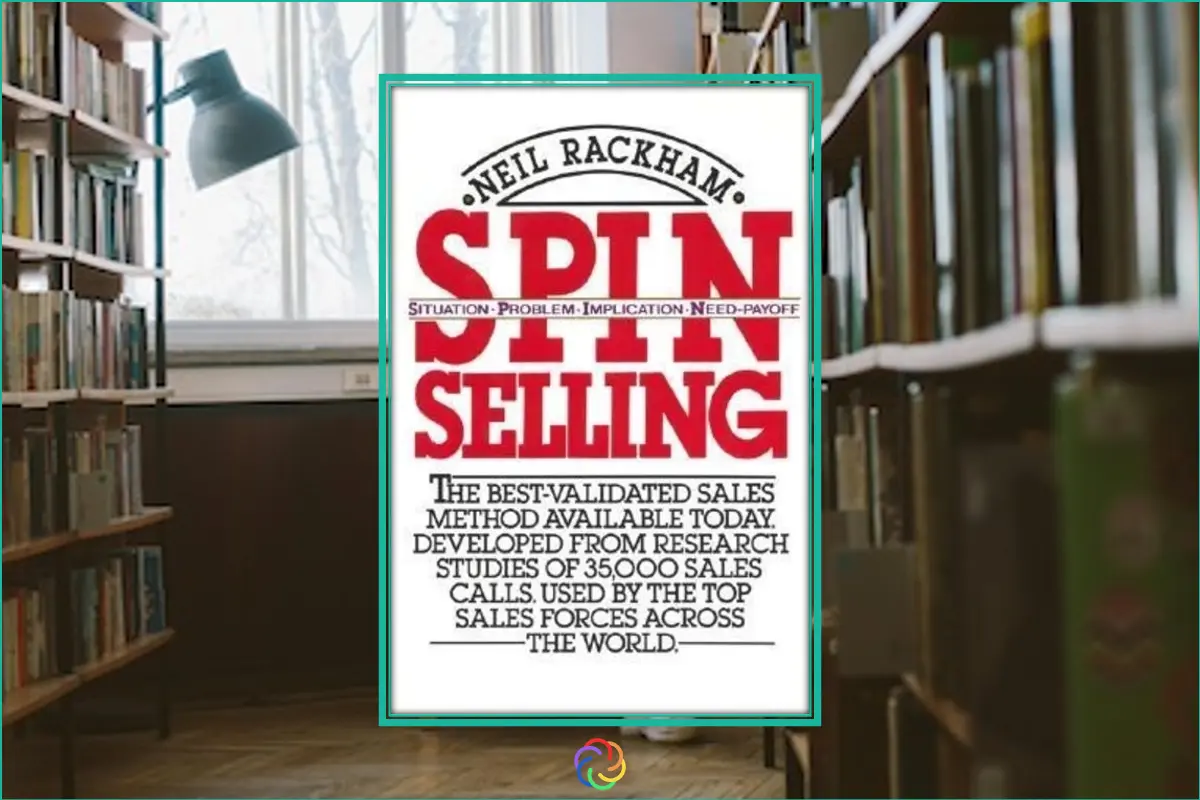“SPIN Selling” is a groundbreaking sales-essential book, written by Neil Rackham, first published in 1988. Rackham, a renowned sales expert and researcher, revolutionized the way we understand and practice sales, particularly in complex, high-value B2B (business-to-business) environments. Unlike traditional sales books that rely on anecdotal advice, Rackham’s work is rooted in extensive research. Over 12 years, he and his team at Huthwaite, a sales performance consultancy, analyzed over 35,000 sales calls across 23 countries. This research formed the backbone of “SPIN Selling,” making it one of the most evidence-based sales methodologies ever written.
The book has received widespread acclaim and is considered a must-read for sales professionals. It has been translated into multiple languages and has sold millions of copies worldwide. Institutions like Harvard Business School have recommended it, and it’s often cited as a foundational text in sales training programs. Rackham’s work has also influenced other sales thought leaders, including authors like Daniel Pink and Jeffrey Gitomer.
Despite its success, “SPIN Selling” has faced some criticism. Some argue that its methodology is more suited to large, complex sales rather than smaller, transactional ones. Others feel that the SPIN model can feel formulaic if not applied with flexibility. However, these critiques are minor compared to the book’s overall impact and enduring relevance.
The Core Philosophy of “SPIN Selling”
At its heart, “SPIN Selling” challenges traditional sales techniques, which often focus on closing deals quickly or using high-pressure tactics. Rackham argues that these methods are ineffective in complex sales, where the stakes are higher, and the decision-making process is more nuanced. Instead, he introduces the SPIN model, which emphasizes understanding the customer’s needs and building value through thoughtful questioning.
The SPIN acronym stands for:
- Situation
- Problem
- Implication
- Need-Payoff
Rackham’s research showed that top performers in complex sales don’t rely on traditional closing techniques. Instead, they excel at asking the right questions to uncover the customer’s pain points and demonstrate how their solution can address those issues. This approach shifts the focus from selling to helping, creating a more consultative and collaborative relationship with the customer.
The Four Stages of the SPIN Model
1. Situation Questions
Situation questions are designed to gather basic information about the customer’s current environment. These questions help the seller understand the context in which the customer operates. For example:
- “How many employees do you have?”
- “What software are you currently using?”
While these questions are necessary, Rackham cautions against overusing them. His research found that less successful salespeople tend to ask too many situation questions, which can bore the customer and stall the conversation. Instead, he advises using them sparingly and only to gather essential background information.
“Situation questions are important, but they should be used as a foundation, not the focus of the conversation.”
2. Problem Questions
Problem questions aim to uncover the customer’s pain points or challenges. These questions dig deeper into the issues the customer is facing and help the seller identify potential areas where their solution can add value. Examples include:
- “What challenges are you experiencing with your current system?”
- “Are there any inefficiencies in your workflow?”
Rackham’s research revealed that top performers ask significantly more problem questions than average performers. By focusing on the customer’s problems, sellers can position themselves as problem-solvers rather than mere vendors.
“The best salespeople are those who can uncover the customer’s problems and make them feel understood.”
3. Implication Questions
Implication questions are the most powerful yet underutilized part of the SPIN model. These questions help the customer understand the consequences of their problems and why they need to take action. For instance:
- “How is this issue affecting your team’s productivity?”
- “What impact does this have on your bottom line?”
Rackham emphasizes that implication questions are critical in complex sales because they amplify the customer’s pain and create a sense of urgency. His research showed that high-performing salespeople ask 2-3 times more implication questions than their peers. By doing so, they help the customer see the full scope of the problem and the value of solving it.
“Implication questions are the bridge between identifying a problem and motivating the customer to act.”
4. Need-Payoff Questions
Need-payoff questions shift the focus from the problem to the solution. These questions help the customer articulate the benefits of addressing their issues and how the seller’s solution can meet their needs. Examples include:
- “How would this solution improve your team’s efficiency?”
- “What value would this bring to your organization?”
Rackham found that need-payoff questions are highly effective in building commitment and closing deals. They encourage the customer to envision the positive outcomes of their decision, making them more likely to move forward.
“Need-payoff questions help the customer sell themselves on the solution.”
The Importance of Building Value
One of the key insights from “SPIN Selling” is that successful salespeople focus on building value rather than pushing for a quick close. Rackham argues that traditional closing techniques, such as the “assumptive close” or the “alternative close,” are often counterproductive in complex sales. Instead, he advocates for a more consultative approach where the seller helps the customer see the value of their solution.
For example, Rackham shares a case study where a salesperson selling industrial equipment avoided pushing for a close. Instead, they used implication and need-payoff questions to help the customer realize how much money they were losing due to inefficiencies. By the end of the conversation, the customer was eager to buy, and the deal closed without any pressure.
“Successful selling is not about pushing a product; it’s about understanding the customer’s needs and helping them achieve their goals.”
The Role of Objections
Rackham also addresses how to handle objections, a common challenge in sales. He argues that objections often arise because the seller hasn’t fully understood or addressed the customer’s needs. By using the SPIN model, sellers can preempt many objections by uncovering and addressing concerns early in the conversation.
For instance, if a customer objects to the price, it may indicate that the seller hasn’t effectively demonstrated the value of their solution. By revisiting implication and need-payoff questions, the seller can reinforce the benefits and justify the cost.
“Objections are often a sign that the seller hasn’t done enough to build value.”
Practical Applications and Examples
To illustrate the SPIN model in action, Rackham provides numerous examples from his research. One notable case involves a salesperson selling a high-tech medical device. Initially, the customer was hesitant due to the high cost. However, by asking implication questions, the salesperson helped the customer realize that the device could significantly reduce patient recovery times, leading to higher bed turnover and increased revenue for the hospital. This shifted the conversation from cost to value, and the customer ultimately decided to purchase the device.
Criticism and Limitations
While “SPIN Selling” has been widely praised, it’s not without its critics. Some argue that the SPIN model is too rigid and may not work well in fast-paced, transactional sales environments. Others feel that the emphasis on questioning can make the sales process feel overly scripted if not applied with nuance. However, Rackham himself acknowledges that the model is most effective in complex, high-value sales and may need to be adapted for other contexts.
Conclusion: Why “SPIN Selling” Still Matters Today
Over three decades after its publication, “SPIN Selling” remains a cornerstone of modern sales methodology. Its evidence-based approach and focus on building value through consultative selling have stood the test of time. Whether you’re a seasoned sales professional or new to the field, the principles outlined in this book can help you build stronger relationships with customers, close more deals, and ultimately drive greater success.
“The essence of selling is not in the close, but in the discovery of needs and the creation of value.”
By mastering the SPIN model, you can transform your sales approach and achieve lasting results.



